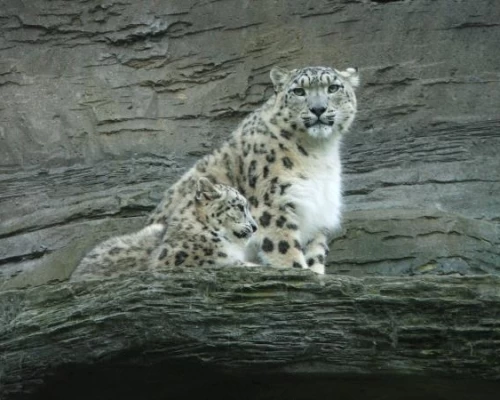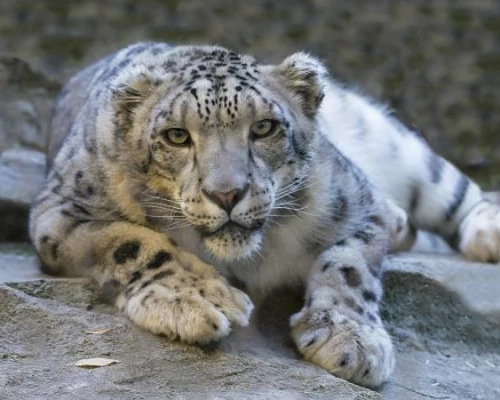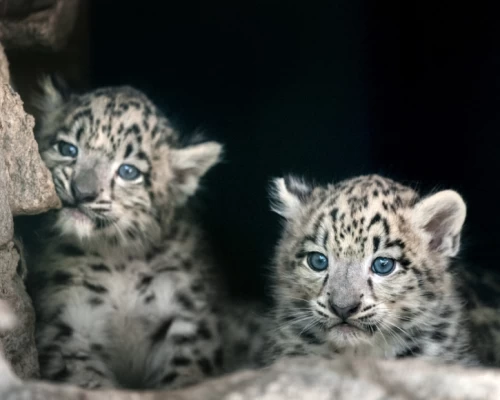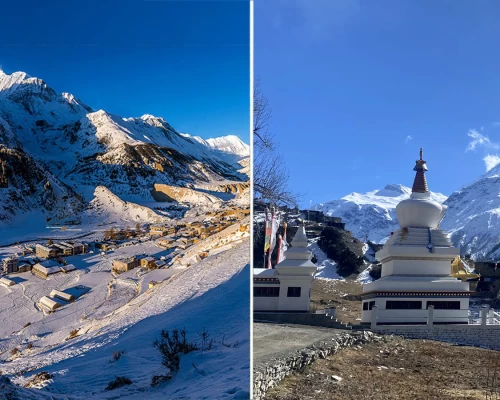The snow leopard, also known as the "ghost of the mountains," is a solitary and elusive creature found in the Himalayan country of Nepal. With its thick fur, which provides insulation against the cold temperatures, and its large size, the snow leopard is a majestic predator that can be found as high up as 16,400 feet in the snow-covered mountains.
Sadly, the snow leopard is an endangered species, with only around 4,000 to 6,000 left in the world. Deforestation is a major threat to their population, as it reduces their habitat and forces them to move into human-populated areas, where they are at risk of poaching. Despite these challenges, the snow leopard remains a breathtakingly beautiful animal, with dense, smoky-grey fur covered in open, dark grey rosettes that help it blend in with the rocky hillsides of the mountains.
Nepal is one of the major habitats for the snow leopard, along with other Himalayan countries such as China, India, and Pakistan. The country offers a chance to witness these incredible creatures in their natural habitat, although sightings are rare and require patience and perseverance. Some of the mountain areas in Nepal where snow leopards have been spotted include Dolpo, Everest Region, and other Himalayan regions.
The snow leopard's behavior is characterized by its shy and elusive nature. It is most active during dawn and dusk, and it prefers to hunt during the mornings and evenings. Snow leopards are nomadic, often traveling alone along ridge lines in search of prey. While they are known to be powerful predators, there are no records of snow leopards attacking humans. In fact, they tend to avoid human presence and will run away when disturbed.
The life cycle of a snow leopard involves mating during the winter months, with the female giving birth to cubs in June or July after a gestation period of 93 to 110 days. The mother raises her cubs alone, providing them with food and shelter until they reach maturity. Snow leopards have a complex nature, adapting to the harsh conditions of their habitat with their unique anatomical features. They have a whitish coat with black spots, a long tail for balance, and large paws to walk on rocks and snow.
However, the snow leopard faces numerous threats to its survival. These include poaching for the illegal fur trade and traditional medicine, loss of prey due to human settlements and livestock, conflicts with herders resulting in retaliatory killings, loss of habitat due to human encroachment, and a lack of awareness and effective protection measures. Conservation efforts by organizations such as WWF, the National Trust for Nature Conservation, and the Snow Leopard Conservation Committee are ongoing, but more needs to be done to protect this magnificent species.
In Nepal, snow leopards can be sighted and documented by conservationists, locals, and photographers who spend days in search of these elusive creatures. Some areas in Nepal, such as Upper Dolpo, Mugu, Manang, Mustang, Gorkha and Taplejung districts, have a higher likelihood of snow leopard sightings. However, sightings are never guaranteed, and it often requires trekking to remote and potential zones to increase the chances of an encounter.
The snow leopard's name, Panthera uncia, reflects its origin and uniqueness. It is called the "ghost of the mountains" due to its solitary nature and ability to blend in with its surroundings. Efforts to conserve the snow leopard in Nepal include legal protection, awareness campaigns, tracking through GPS collaring, and the implementation of the Snow Leopard Conservation Action Plan.
The snow leopard's habitat blocks in Nepal include the Western, Manaslu, Rolwaling, Sagarmatha, Makalu-Barun, and Kangchenjunga regions, covering an estimated area of over in Asia, with an estimated 4000-6000 remaining in the wild. The snow leopard is listed as endangered on the International Union for Conservation of Nature (IUCN) Red List, and its population is declining due to habitat loss and fragmentation, poaching, and retaliatory killing. In Nepal, the government has launched several conservation programs to protect the snow leopard and its habitat, including the Snow Leopard Conservation Action Plan and the Snow Leopard and Prey Base Monitoring Program.
Snow leopards are some of the most elusive and rarest animals in the world. They are found in the high-altitude regions of the Himalayas and are incredibly difficult to spot. However, if you are up for a challenge, then the Snow Leopard Tracking Trek in Nepal with Pink Mountain Travels and Excursion is the perfect adventure for you.
Pink Mountain Travels and Excursion is a leading adventure travel company in Nepal that specializes in providing treks and tours to remote and off-the-beaten-path locations. Their Snow Leopard Tracking Trek is a once-in-a-lifetime experience that will take you to the heart of the Himalayas, where you can witness these majestic creatures in their natural habitat.
The Snow Leopard Tracking Trek in Nepal is an 18-day adventure that starts in Kathmandu and takes you to the beautiful Annapurna Conservation Area in the western part of the country. The trek is designed to give you the best possible chance of spotting a snow leopard in the wild. It is a challenging trek, but the rewards are well worth the effort.
The trek begins with a scenic drive from Kathmandu to Pokhara, where you will spend the night before starting the trek. The next day, you will drive to the village of Nayapul, where you will begin your trek. You will hike through beautiful forests, cross mountain rivers, and pass through traditional Nepalese villages on your way to the Annapurna Conservation Area.
The Snow Leopard Tracking Trek in Nepal is not just about spotting a snow leopard. It is also about immersing yourself in the local culture and experiencing the beauty of the Himalayan landscape. You will stay in traditional tea houses and campsites, and you will have the opportunity to interact with the local people and learn about their way of life.
As you hike through the Annapurna Conservation Area, you will be accompanied by experienced guides and porters who are familiar with the area and its wildlife. They will help you track snow leopards and other rare animals, such as Himalayan black bears, Tibetan wolves, and red pandas.
The Snow Leopard Tracking Trek in Nepal is a camping trek, which means that you will spend most of your nights in tents. The campsites are located in some of the most stunning locations in the Himalayas, and you will be surrounded by snow-capped mountains and pristine wilderness.
The best time to do the Snow Leopard Tracking Trek in Nepal is from October to March, which is the winter season in Nepal. During this time, the snow leopards come down to lower elevations in search of food, making it easier to spot them. However, the weather can be harsh, with temperatures dropping to below freezing at night.
The Snow Leopard Tracking Trek in Nepal with Pink Mountain Travels and Excursion is not for everyone. It is a challenging trek that requires a good level of fitness and stamina. You will be hiking for several hours each day, and some of the trails are steep and rocky. However, if you are up for the challenge, then the rewards are well worth it.
Here are details information about Snow leaopard Tracking Trek to Nepal one by one as follow :
Snow Leopard Tracking in Nepal: Snow Leopard tracking in Nepal is a thrilling and adventurous experience for nature enthusiasts who want to witness the rare and elusive snow leopard in its natural habitat. This activity involves tracking the snow leopard through the rugged Himalayan terrain of Nepal, using expert guidance from trained guides and trackers. The snow leopard is a highly endangered species, and the Himalayas of Nepal are one of the few remaining places where it can be found. The tracking process may require some physical endurance, but the reward of spotting a snow leopard in its natural habitat is an unforgettable experience.
Snow Leopard Trek in Nepal: A Snow Leopard Trek in Nepal is a challenging and rewarding adventure that takes you deep into the Himalayas to explore the natural habitat of this magnificent and elusive animal. This trek takes you through some of the most beautiful and remote areas of Nepal, offering stunning views of the towering peaks and pristine landscapes. Along the way, you'll have the opportunity to encounter a variety of wildlife, including the snow leopard, as well as local communities and their unique culture. This trek is suitable for experienced trekkers who are physically fit and able to cope with the rugged terrain.
Snow Leopard Searching Trek in Nepal: A Snow Leopard Searching Trek in Nepal is a specialized trekking experience that combines the thrill of a Himalayan trek with the excitement of searching for the elusive snow leopard. This trek involves hiking through the rugged terrain of the Himalayas, with the guidance of expert trackers and guides who have extensive knowledge of the snow leopard's habits and behavior. The trek also offers the opportunity to explore the local culture and interact with the local communities. This trek is designed for nature enthusiasts who are physically fit and ready for a challenging adventure.
Snow Leopard Encounter in Nepal: A Snow Leopard Encounter in Nepal is a once-in-a-lifetime opportunity to witness the rare and elusive snow leopard in its natural habitat. This experience involves tracking the snow leopard through the rugged terrain of the Himalayas, with the help of expert guides and trackers. The encounter can last anywhere from a few minutes to several hours, depending on the snow leopard's movements and behavior. This experience is ideal for wildlife enthusiasts who want to get up close and personal with one of the world's most endangered and majestic animals.
Snow Leopard Encounters tracking trip Nepal: A Snow Leopard Encounters tracking trip in Nepal is an immersive wildlife experience that combines the thrill of tracking the snow leopard with the adventure of trekking through the Himalayas. This trip is led by expert trackers and guides who have extensive knowledge of the snow leopard's behavior and habits. Along the way, you'll have the opportunity to explore the local culture and interact with the local communities. This trip is designed for nature enthusiasts who are physically fit and ready for a challenging adventure.
Snow Leopard Camping Trekking in Nepal: Embark on an adventure like no other with our Snow Leopard Camping Trekking package in Nepal. This unique trekking experience takes you on a journey through the remote and rugged terrain of Nepal in search of the elusive Snow Leopard. Accompanied by experienced guides and porters, you will set up camp each night under the stars in the midst of the stunning Himalayan landscape. Wake up to the breathtaking views of snow-capped peaks, glaciers, and alpine forests, and spend your days tracking the Snow Leopard in its natural habitat. Along the way, you will also have the opportunity to encounter other wildlife, such as Himalayan Blue Sheep, Musk Deer, and various bird species.
Snow Leopard Nepal Trekking: Join us on an unforgettable Snow Leopard Nepal Trekking adventure. This trekking package is designed for wildlife enthusiasts and nature lovers who want to witness the magnificent Snow Leopard in its natural habitat. Nepal is home to a significant population of these elusive big cats, and our experienced guides will lead you on a trekking expedition through the rugged terrain of the Himalayan Mountains to track and spot them. In addition to the Snow Leopard, you will have the chance to witness other incredible wildlife, such as Himalayan Blue Sheep, Musk Deer, and various bird species. Our Snow Leopard Nepal Trekking package is an ideal adventure for anyone seeking a unique and unforgettable experience in the heart of the Himalayas.
In conclusion, the snow leopard in Nepal is a magnificent and rare creature that inhabits the high mountain ranges of the Himalayas. Despite its solitary and elusive nature, it remains an important and iconic species in the region, and efforts are being made to conserve its dwindling population. With the help of conservation programs and public awareness, we can ensure the survival of this beautiful animal for future generations to enjoy.









